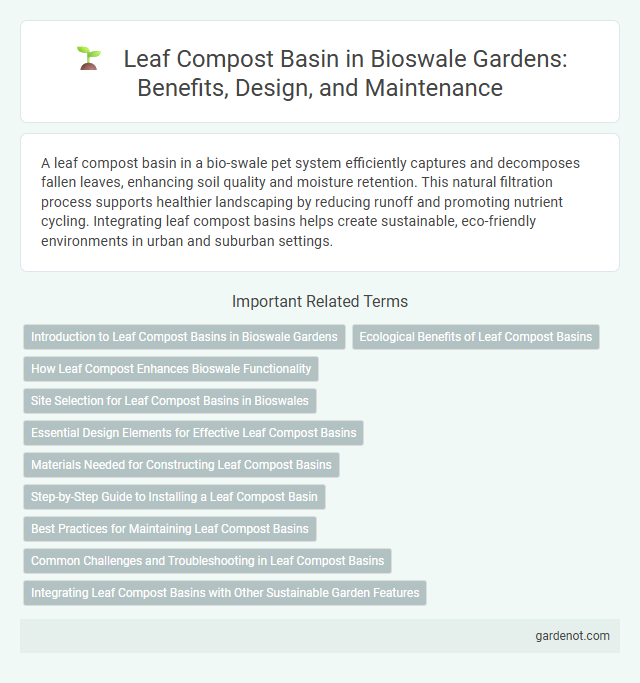A leaf compost basin in a bio-swale pet system efficiently captures and decomposes fallen leaves, enhancing soil quality and moisture retention. This natural filtration process supports healthier landscaping by reducing runoff and promoting nutrient cycling. Integrating leaf compost basins helps create sustainable, eco-friendly environments in urban and suburban settings.
Introduction to Leaf Compost Basins in Bioswale Gardens
Leaf compost basins in bioswale gardens serve as crucial components for managing organic waste and enhancing soil health. These basins collect fallen leaves and facilitate natural decomposition, producing nutrient-rich compost that improves moisture retention and supports plant growth within the swale. Incorporating leaf compost basins optimizes the bioswale's capacity to filter pollutants and sustain a healthy urban ecosystem.
Ecological Benefits of Leaf Compost Basins
Leaf compost basins enhance soil fertility by naturally enriching the ground with organic matter and essential nutrients, promoting healthier plant growth and increased biodiversity. These basins improve water retention and reduce surface runoff, thus mitigating erosion and preventing pollutants from entering local waterways. Serving as microhabitats, leaf compost basins support diverse soil microorganisms and beneficial insects, fostering a balanced and resilient ecosystem.
How Leaf Compost Enhances Bioswale Functionality
Leaf compost enriches bioswale soil by increasing organic matter content, which improves water retention and nutrient availability. This enhanced soil structure promotes microbial activity that breaks down pollutants, boosting the bioswale's filtration capacity. The nutrient-rich compost supports healthier plant growth, which stabilizes soil and enhances stormwater absorption efficiency.
Site Selection for Leaf Compost Basins in Bioswales
Site selection for leaf compost basins in bioswales requires well-drained areas with adequate sunlight to optimize decomposition of organic matter. Proximity to stormwater inflow points ensures efficient capture and treatment of leaf litter, enhancing nutrient absorption and water filtration. The basin should be positioned to prevent waterlogging while maintaining soil permeability for effective biofiltration and microbial activity.
Essential Design Elements for Effective Leaf Compost Basins
Effective leaf compost basins require key design elements such as adequate aeration through slatted or mesh sides to promote microbial activity and prevent odor buildup. Proper drainage is essential to avoid waterlogging, which can slow decomposition and create anaerobic conditions. A sturdy frame constructed from durable, weather-resistant materials ensures structural integrity and longevity for continuous leaf composting.
Materials Needed for Constructing Leaf Compost Basins
Leaf compost basins require materials such as untreated wood or recycled plastic lumber for the frame, wire mesh or hardware cloth for ventilation and pest control, and natural fiber mats or landscape fabric to allow drainage while retaining moisture. Using biodegradable liners enhances decomposition and eases maintenance. Organic leaves and garden waste form the core composting material, promoting nutrient-rich soil through aeration and moisture regulation.
Step-by-Step Guide to Installing a Leaf Compost Basin
Create a bio-swale by first selecting a low-lying area where water naturally collects, then dig a shallow basin approximately 2 feet deep and 4 feet wide to direct runoff into the composting zone. Layer leaves, organic debris, and soil within the basin to promote microbial activity that accelerates decomposition and improves water filtration. Maintain the leaf compost basin by regularly adding fresh leaves, keeping the material moist, and occasionally turning the compost to enhance aeration and nutrient cycling.
Best Practices for Maintaining Leaf Compost Basins
Maintaining leaf compost basins in bio-swales requires regular monitoring to prevent clogs and ensure efficient water infiltration, which enhances stormwater management. Incorporate shredded leaves to improve aeration and accelerate decomposition, while periodically turning the compost to maintain optimal microbial activity. Remove excess debris and inspect basin edges to prevent erosion and maintain structural integrity for long-term performance.
Common Challenges and Troubleshooting in Leaf Compost Basins
Leaf compost basins often face challenges such as poor aeration, which slows down decomposition and causes odor issues due to anaerobic conditions. Excess moisture can lead to waterlogging and leachate problems, requiring proper drainage solutions like adding coarse materials or creating drainage channels. Regular turning of the compost and monitoring moisture levels are effective troubleshooting methods to maintain optimal microbial activity and ensure efficient leaf litter breakdown.
Integrating Leaf Compost Basins with Other Sustainable Garden Features
Integrating leaf compost basins with rain gardens and permeable pavements enhances stormwater management by improving water infiltration and reducing runoff. Combining these features supports nutrient recycling and promotes soil health, contributing to a resilient urban ecosystem. Utilizing native plants around basins further boosts biodiversity and stabilizes the soil structure.
Leaf compost basin Infographic

 gardenot.com
gardenot.com